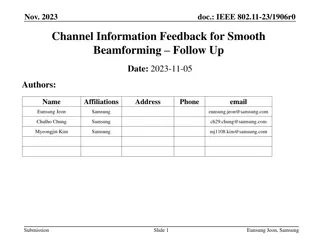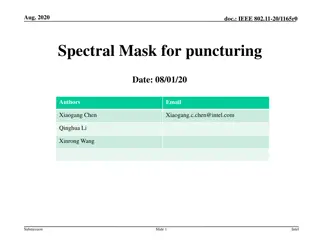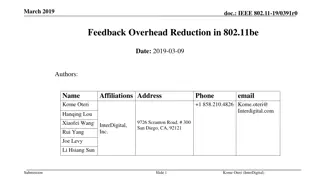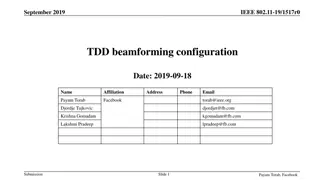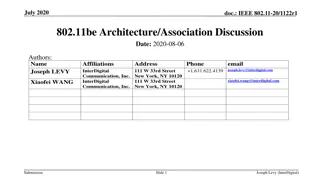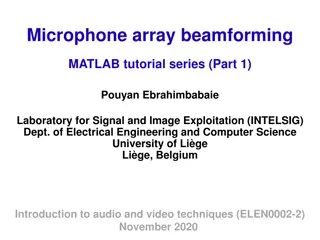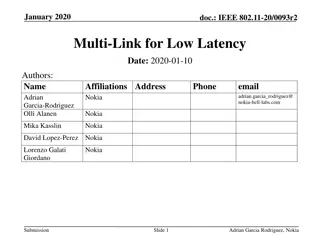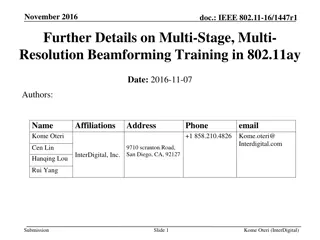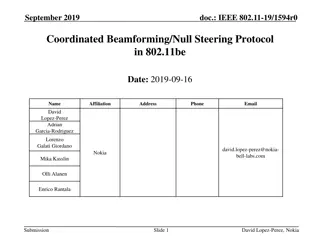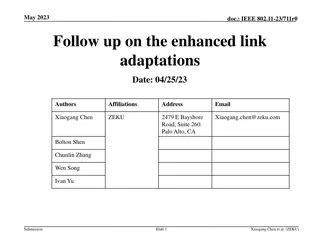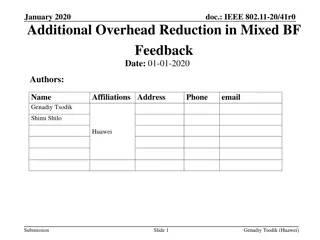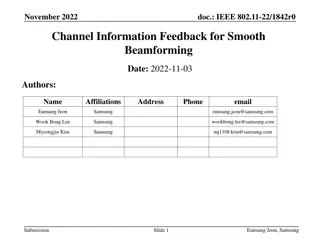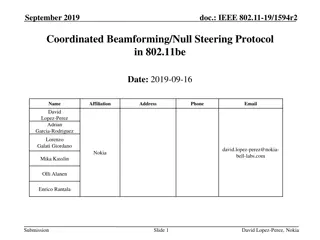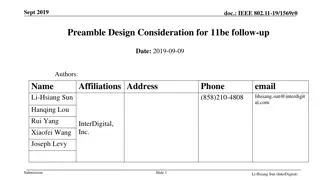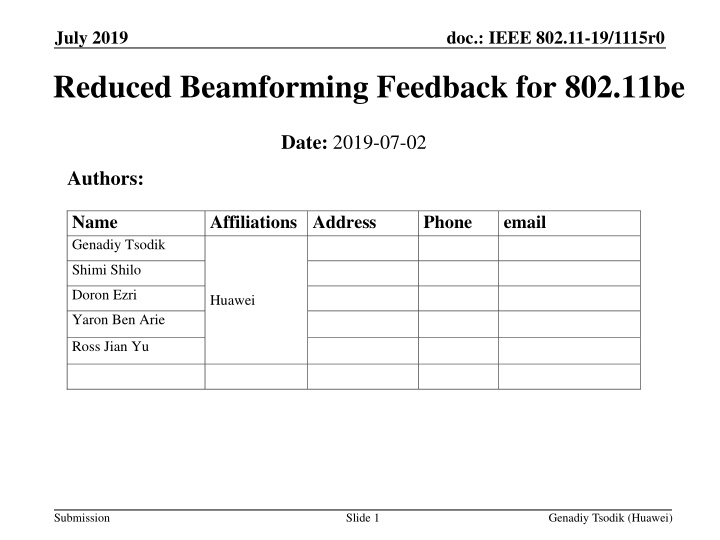
Enhancing Beamforming for Next-Generation Wireless Communication
Explore the challenges and innovations in beamforming for IEEE 802.11be standard, focusing on increased spatial streams and MU-MIMO groups. Addressing the impact of larger precoding matrices while maintaining backward compatibility, the study delves into optimizing existing beamforming schemes for improved performance. Wideband beamforming techniques are also discussed, highlighting the benefits of reduced feedback requirements and the trade-offs between feedback overhead and performance degradation.
Download Presentation

Please find below an Image/Link to download the presentation.
The content on the website is provided AS IS for your information and personal use only. It may not be sold, licensed, or shared on other websites without obtaining consent from the author. If you encounter any issues during the download, it is possible that the publisher has removed the file from their server.
You are allowed to download the files provided on this website for personal or commercial use, subject to the condition that they are used lawfully. All files are the property of their respective owners.
The content on the website is provided AS IS for your information and personal use only. It may not be sold, licensed, or shared on other websites without obtaining consent from the author.
E N D
Presentation Transcript
July 2019 doc.: IEEE 802.11-19/1115r0 Reduced Beamforming Feedback for 802.11be Date: 2019-07-02 Authors: Name Genadiy Tsodik Affiliations Address Phone email Shimi Shilo Doron Ezri Huawei Yaron Ben Arie Ross Jian Yu Submission Slide 1 Genadiy Tsodik (Huawei)
July 2019 doc.: IEEE 802.11-19/1115r0 Introduction Beamforming is one of the key techniques used in wireless communication to achieve significant gain in terms of performance Various feedback schemes were considered and supported by 802.11n; explicit compressed feedback was selected within 11ac/11ax 11be introduces new challenges [1] related to MIMO and beamforming, in particular supporting more spatial streams and larger MU-MIMO groups Some contributions have already discussed the new challenges and what directions may be used for next generation beamforming schemes and procedures [2], [3] In this contribution we want to study the impact of more spatial streams (and hence larger precoding matrix) on the existing beamforming scheme, and understand what can be done in terms of optimization with minimal impact on the basic building blocks Submission Slide 2 Genadiy Tsodik (Huawei)
July 2019 doc.: IEEE 802.11-19/1115r0 Beamforming Challenges in 802.11be The main issue in 802.11be is related to the larger number of streams (16) that is being considered, which implies both larger MIMO schemes and larger MU-MIMO groups The main impact on the beamforming procedure is a significant increase in precoder feedback size caused by the larger channel matrix, while backward compatibility requires to maintain SVD based beamforming We believe that practical and theoretical experience achieved during the evolution of 802.11 standards should be considered in the design of the next generation schemes and procedures with minimal required changes to existing hardware designs The currently adopted beamfoming procedure/mechanism is based on the following principles: Explicit Beamforming precoder is obtained from estimated channel matrix, reflecting Tx and Rx chains that are used for data transmission SVD based precoder calculation sounding procedure is based today on applying SVD on the channel matrix at the beamformee side Compressed feedback precoder is transmitted in compressed manner, and different compression schemes are defined by the standard Submission Slide 3 Genadiy Tsodik (Huawei)
July 2019 doc.: IEEE 802.11-19/1115r0 Wideband Beamforming SU MIMO, TGnD, Nss = 2, 8 Tx Ant, MCS4 Today the precoder is calculated in frequency domain per tone (or per group of tones based on the Ng value) However, in many scenarios a wideband precoder (same for the large group of tones or entire BW, also known as time-domain precoder) may be applied with relatively small degradation in the performance ~8dB There are several techniques to obtain such a wideband precoder (a simple example is averaging a channel/precoder over all the tones, similar to large Ng value) SU MIMO, TGnD, Nss = 2, 16 Tx Ant, MCS4 The main advantage of wideband precoding is the very small size of feedback that is required to be transmitted (can allow larger number of bits to be used in order to preserve the accuracy) ~10dB The results (see on the right) show that wideband precoding yields a reasonable degradation (~2dB) that introduces a trade-off between feedback size overhead and PER Submission Slide 4 Genadiy Tsodik (Huawei)
July 2019 doc.: IEEE 802.11-19/1115r0 Mixed Beamforming Though wideband precoding provides a very attractive solution in terms of feedback size, it leads to a degradation in case of large MIMO schemes and MU-MIMO One possible solution is mixed beamforming (digitally implemented hybrid beamforming) where the narrowband precoder is calculated on top of the wideband precoder Channel Estimation ?? - per tone matrices of size NxM Wideband Precoder Calculation In the ensuing discussion we will use the term narrowband precoder only in connection with mixed BF ??? - wideband precoder of size MxK Narrowband precoder matrix size is smaller than the regular per-tone precoder (K < N) Narrowband Equivalent Matrix Calculation ??= ????? This technique leads to smaller per-tone precoders (more than 50% feedback size reduction compared with regular per-tone precoder) while all the basic building blocks of the existing beamforming procedure are preserved ??? of size ? ???(smaller than regular per-tone precoder!) Narrowband Precoder Calculation Submission Slide 5 Genadiy Tsodik (Huawei)
July 2019 doc.: IEEE 802.11-19/1115r0 Mixed BF Performance MU-MIMO, TGnD, Nss = 2, 4 STA, 16 Tx Ant, MCS4 We look at the performance of MU-MIMO with mixed BF for with 4 STAs and using different values of K The results show that we can adjust the parameters of mixed beamforming in order to produce a very small performance gap (less than 0.5dB for K > 8) compared with the regular per-tone precoder In the table below we present the gain in terms of reduced feedback size that can be achieved from mixed beamforming in some scenarios Basic Parameters NB WB+NB Saving NB WB+NB Saving NB WB+NB Saving 20MHz Ng = NB WB+NB Saving Performance Loss NRx (Nss) 2 4 6 2 2 8 12 Angles WB 26 44 54 58 58 184 228 Angles NB 18 28 30 26 42 56 132 Nbits WB 8 8 8 8 8 8 8 Nbits NB 8 8 8 8 8 8 8 NTx K 20MHz Ng = 4 % 80MHz Ng = 4 % % 80MHz Ng = 16 % 16 8 8 8 16 16 16 16 6 6 6 8 1664 2816 3456 3712 3712 11776 14592 1178 1836 1974 1722 2746 3768 8676 29 34 42 53 26 68 40 6656 11264 13824 14848 14848 10810 47104 14520 58368 34020 4634 7212 7734 6714 30 35 44 54 27 69 41 416 704 864 928 928 2944 3648 314 492 534 474 730 1080 2340 24 30 38 48 21 63 35 1664 2816 3456 3712 3712 11776 14592 1178 1836 1974 1722 2746 3768 8676 29 34 42 53 26 68 40 0.5dB 0.5dB 1dB 0.2dB 0.1dB 0.9dB 1dB 12 8 12 Submission Slide 6 Genadiy Tsodik (Huawei)
July 2019 doc.: IEEE 802.11-19/1115r0 Mixed Beamforming Properties Mixed beamforming yields performance almost identical to per-tone precoding, and leads to significant feedback size reduction We want to investigate the properties of mixed beanforming and understand how efficient this method could be The main intuition is that the wideband precoder addresses the directions of channel multipath and creates the main beams while the narrowband precoder implements fine tuning of the beams with small changes FFT Wideband BF Beam Narrowband Beam Correction Submission Slide 7 Genadiy Tsodik (Huawei)
July 2019 doc.: IEEE 802.11-19/1115r0 Mixed Beamforming Math Here we address the mathematical explanation to the intuitive property mentioned in the previous slide The received signal in time domain is given by ? ? = ?? ? ???(??)?? where s is the transmitted signal, x corresponds to directions of the multipath and ? is the complex coefficient of each path The frequency domain channel is given by ?= ?? ?2????/??(??)?? If we compute a wideband precoder based on the average channel matrix covariance over the entire BW we get 1 ? ???? ? ??? ??|??|2 ? This means that the wideband precoder tries to estimate the main directions of time domain channel, while narrowband precoders provide a small correction for the per-tone combination of phases Thus we understand that with the mixed BF solution, a narrowband precoder requires less degrees of freedom to achieve the same accuracy compared with regular per-tone precoder The conclusion is that applying mixed beamforming allows us to achieve desired performance with less bits used for the narrowband precoder and thus we can get a significant reduction in feedback size Submission Slide 8 Genadiy Tsodik (Huawei)
July 2019 doc.: IEEE 802.11-19/1115r0 Mixed Beamforming SNR Impact Let us now analyze the impact of applying mixed precoding on the SNR 0.15dB The Zero-Forcing SNR of the post BF channel is given by the covariance matrix of the equivalent channel ? after applying wideband precoding 0.35dB We compared between the SNR after applying per-tone precoding and the SNR after applying wideband precoding with different K values The figure on the right shows the CCDF of the difference in dB between the two SNR results These results represent the impact that narrowband precoding may have on the total per-tone SNR We can see, for example, that for K = 10 the maximum SNR correction that can be achieved by narrowband precoding is less than 0.15dB in 90% of the cases and is less than 0.35dB in 99% of the cases Submission Slide 9 Genadiy Tsodik (Huawei)
July 2019 doc.: IEEE 802.11-19/1115r0 Complexity Aspects The main part of precoder computation in the existing procedure is an SVD applied on the channel matrix at each tone or group of tones (defined by Ng) Assuming the wideband precoder is obtained based on averaging the covariance of the channel matrix, mixed BF includes the following steps: 1 ? ???? Covariance matrix computation C = SVD or Eigenvector decomposition of C Equivalent per-tone (or Ng tones) equivalent channel computation ??= ????? SVD of ?? Eigenvector decomposition of an NxN matrix requires ~12.5*N^3 + 6*N^2 Complex Multiplications (CM), similar to SVD, while covariance matrix calculation requires ~0.5*N^3 CMs Thus in case of 16 Tx antennas and BW of 80MHz with Ng = 4, mixed BF with K = 10 results in a total number of ~4.5M CMs while regular per-tone precoding will require >13M CMs Submission Slide 10 Genadiy Tsodik (Huawei)
July 2019 doc.: IEEE 802.11-19/1115r0 Conclusions The new challenges for beamforming procedure introduced by 802.11be features can be addressed with reasonable overhead by wideband and mixed BF Both wideband and narrowband precoders can be obtained using the same operations (e.g. SVD) means minor changes in implementation and no increase in computational complexity Wideband precoding is more robust to temporal changes in channel, thus allows to minimize the feedback overhead during updates Mixed Beamforming implies very small impact on the gain compared with per-tone precoder, thus the overhead of feedback size can be managed with very small degradation to the performance Submission Slide 11 Genadiy Tsodik (Huawei)
July 2019 doc.: IEEE 802.11-19/1115r0 References [1] 11-18/1231r6-0eht-eht-draft-proposed-par. [2] 11-18-1184-01-0eht-eht-discussions-on-throughput-enhancement [3] 03-19-0391 - Feedback Overhead Reduction in 802.11be Submission Slide 12 Genadiy Tsodik (Huawei)
July 2019 doc.: IEEE 802.11-19/1115r0 Straw Poll 1 Do you agree to increase value of Ng to support wideband precoder? Y/N/A Submission Slide 13 Genadiy Tsodik (Huawei)
July 2019 doc.: IEEE 802.11-19/1115r0 Straw Poll 2 Do you think mixed beamforming should be used in 11be for reducing feedback size? Y/N/A Submission Slide 14 Genadiy Tsodik (Huawei)

